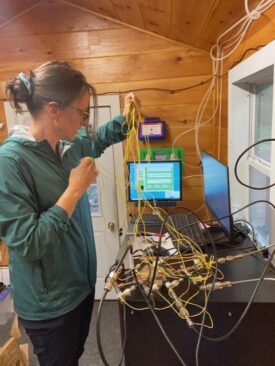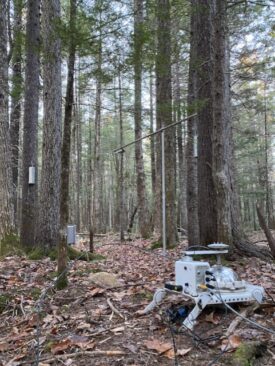
In a single 5cm by 5cm patch of the forest floor, the quality and variety of leaf litter and coarse woody debris varies dramatically. Here, a single patch is sorted to assess its variability. Through this NSF CAREER award, high school students at Piscataway High School will explore the importance of the complexity in the understory.
Mary Whelan, assistant professor in the Department of Environmental Sciences, won a prestigious CAREER Award from the National Scientific Foundation (NSF) for the project, “Constraining land carbon uptake on regional and global scales by enabling the interpretation of two decades of trace gas measurements.” The five-year, $607,772 award from NSF’s Atmospheric Chemistry division is from March 2023 to February 2028.

Mary Whelan sorts through the spaghetti of wires that will determine what stream of air is analyzed by her quantum cascade laser instrument. If it were available, Whelan would choose multiple colors of wire instead of only yellow.
The CAREER award is among the NSF’s “most prestigious awards in support of early-career faculty who have the potential to serve as academic role models in research and education and to lead advances in the mission of their department or organization.”
After earning a doctoral degree from the University of California-Berkeley, Whelan joined the Department of Environmental Sciences at Rutgers in 2019. Some of her dynamic research portfolio was covered in a 2020 Rutgers article.
Whelan is excited about the CAREER award and shared what she is studying in this NSF-funded research project with SEBS/NJAES Newsroom.
What is being studied in this project?
This study focuses on how leaf litter (think the leaves you might rake up) and bryophytes (like moss) change the flow of matter into and out of forests. Ecosystems affect what’s in the air. For example, plant photosynthesis takes up CO2 and microbes in the soil respire CO2. Over many decades, many smart people have studied these interactions in a rigorous way, but there are persistent differences between field observations and our process-based understanding represented in models. One component that is often missing from global models is the fuzzy, sticky, leafy, inconveniently diverse layer of stuff on top of soil. In a forest, this acts as a gatekeeper between what is going on in the soil and interactions with the atmosphere.
What are your objectives?
Ultimately, we want to quantify land carbon uptake over whole continents. Plants take up CO2 through small openings on their leaves called stomata. At the same time, plant roots and soil microbes respire nearly as much CO2. Carbonyl sulfide (OCS) is a gas present everywhere in the atmosphere that gets taken up by plants along with CO2. Few living things on land create OCS. If we measure OCS uptake over a forest, we can get an integrated picture of how much CO2 the plants can take up, without quantifying CO2 respiration. The National Ocean and Atmospheric Administration has been making measurements of OCS in the air over North America for two decades. Our study will fill in remaining knowledge gaps around OCS surface interactions to make greater use of this valuable, long-term dataset.

A long term automated surface sampler is attached to a trace gas analyzer in the forest. These small robots open and close a chamber that allows us to measure the movement of gases between the surface and the atmosphere.
In a boreal forest like Howland Forest in Maine, much of the groundcover has moss, fallen logs, sticks and leaves. Moss can take up OCS like a plant would, but moss don’t have regulated openings. Fallen sticks and “dead” leaves are home to extensive microbial communities. This likely complicates the OCS tracer method. We plan to study and quantify how all the cool stuff on the forest floor changes the conversation between the atmosphere and the forest.
Why does this research matter?
Right now, about a quarter of the CO2 released from fossil fuels is taken up by land ecosystems. Since there is so much respiration happening at the same time and place, it is impossible to tell how much photosynthesis counterbalances respiration through observations of CO2 alone. Sharpening our ability to use OCS as a tracer for land carbon uptake will clarify how much photosynthesis is occurring and how much we can rely on this free carbon removal in the future.

